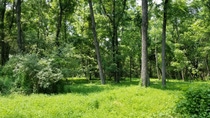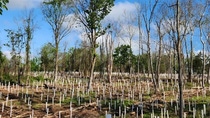Our Stories
Restoring the roots: How BASF is helping reclaim and revive Belvidere forestland

In Belvidere, New Jersey, a threatened forest ecosystem is being brought back to life. Decimated by the Emerald Ash Borer, a destructive species of beetles, and overrun with invasive plants, this landscape is now a powerful example of how science-based solutions and innovation can restore nature. The transformation was made through the strategic use of BASF herbicides—designed to protect native species and promote biodiversity – and the foresight and creativity of the BASF project team.
What started as a challenge to remove diseased ash trees has become a model for how land management, guided by science, can regenerate entire ecosystems.
A smarter way to restore
After discovering that nearly 20% of Ash trees were dead or dying, BASF’s team acted quickly to remove them. But clearing the land uncovered a second issue: invasive plant species spreading fast across roughly 60 acres of the 600 -acre property. To address this, the BASF team developed a targeted herbicide program using the company’s agricultural solutions products known for their precision and safety.
These herbicides are formulated for licensed professionals—not for general use—and are part of a carefully managed strategy to control invasives without harming native growth. Other methods of invasives mitigation, such as controlled burning, have indiscriminate effects on the native flora and fauna. “Properly managed herbicide programs are target focused and designed to only affect invasives species, which is safer for the ecosystem and scientifically guided,” said Vernon Burrows, Senior Remediation Expert at BASF “It’s not about wiping out everything. It’s about knowing what you’re protecting and using the right tools to do it.”
With invasive growth under control, the BASF team introduced native species like American Chestnut and Elm to begin restoring the forest’s natural balance. Soil testing and long-term monitoring will continue to guide the project’s next phases.
Where innovation takes flight
To speed up treatment and reduce labor demands, aerial drones were brought in to assist with herbicide application. These drones helped cover large areas efficiently, while in more delicate zones—such as newly planted areas—trained professionals applied herbicides by hand for greater precision.
What success looks like
While the forest’s restoration is ongoing, the early results are promising:
- Native species are returning and existing populations are increasing
- Invasive plants are under control, allowing native species to regenerate and proliferate
- Sustainable timber programs are in development to offset land management costs
- And most importantly, a science-based approach to herbicide use has been proven effective and environmentally responsible

This project is just one example of BASF’s commitment to sustainable agriculture and land stewardship.
“As a society, we have an obligation to ensure that healthy forests are available for future generations,” said Don Donnelly, New Jersey Natural Resource Conservation Service State Forrester. “Forest stewardship is a long term and on-going investment in the land, and not something that you just do once and then walk away from.”
By offering innovative herbicide solutions backed by research and field-tested results, BASF is helping land managers make smarter, safer decisions for the future of our environment. It’s clear that when BASF’s innovative solutions are guided by a deep commitment to sustainability, even a forest can begin again.
“The BASF Belvidere site has been extremely proactive in making efforts to help the property heal from many past stressors and impacts that have caused the forest to degrade and lose a significant amount of ecosystem function,” said Ryan Hasko, Stewardship Project Director at New Jersey Audubon. “The thoughtful approach to management planning and implementation of restoration efforts aligns well with forest stewardship principles, which promotes the ethos of caring for our forest to ensure that they remain healthy and resilient far into the future.”
Article written by Olivia Jakubowski, published on November 13, 2025.
For media inquiries or to repurpose this article, please contact Lisa Brown.